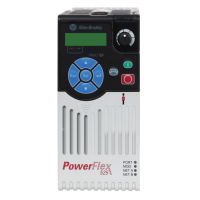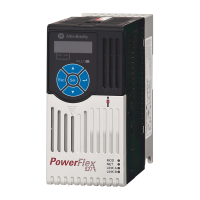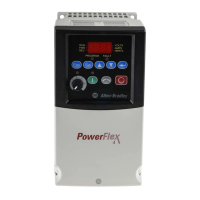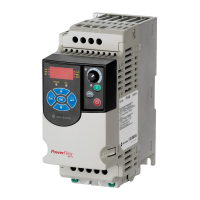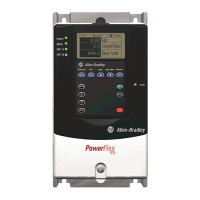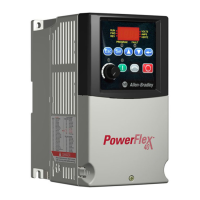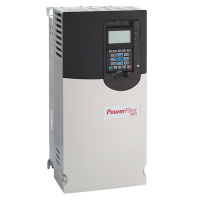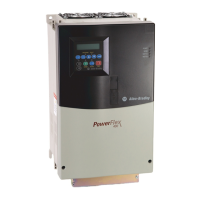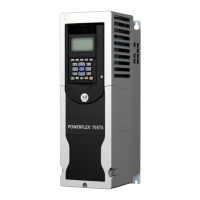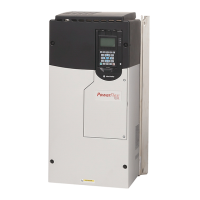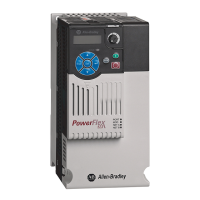
Do you have a question about the Allen-Bradley PowerFlex 523 and is the answer not in the manual?
| Frequency | 50/60 Hz |
|---|---|
| Dimensions | Varies by model |
| Weight | Varies by model |
| Output Voltage | 0 to Input Voltage |
| Power Rating | 0.4-22 kW |
| Control Method | Sensorless Vector Control |
| Enclosure | IP20 |
| Communication | EtherNet/IP |
| Operating Temperature | -20 to 50°C (-4 to 122°F) |
| Storage Temperature | -40 to 85°C (-40 to 185°F) |
| Relative Humidity | 5% to 95% (non-condensing) |
| Input Voltage | 200-240V AC, 380-480V AC |
| Horsepower | 0.5…30 Hp |
Details changes made to the current revision of the manual.
Provides basic information to install, start-up, and troubleshoot the PowerFlex 520-Series Drive.
Identifies qualified personnel and necessary understanding for operating the drive.
Lists publications providing general and specific PowerFlex 520-Series information.
Provides guidance on drive mounting, clearances, and environmental factors.
Details requirements for safely connecting the drive to the AC power supply.
Outlines necessary grounding practices for safety and electrical codes.
Specifies recommended AC line input fuse and circuit breaker information.
Details requirements for safely and correctly wiring the drive's power connections.
Provides guidance and precautions for wiring the drive's input/output terminals.
Details the physical layout and specifications of the control I/O terminal block.
Details RF emission compliance requirements for different categories and filter types.
Provides information on additional requirements for Class C1 and C2 installations.
Outlines the essential tasks for safely and correctly preparing the drive for initial start-up.
Details the function of each key on the drive's keypad for navigation and control.
Explains the process of navigating and modifying drive parameters.
Guides users through setting up the drive using essential parameters from the Basic Program Group.
Explains the three types of drive parameters: ENUM, Numeric, and Bit.
Lists parameters categorized into groups like Basic Display, Basic Program, and Terminal Blocks.
Provides detailed descriptions for parameters related to drive status and output.
Details commonly used parameters for motor setup, start, and speed control.
Describes parameters related to the drive's digital and analog I/O terminals.
Details parameters for configuring network communication settings.
Explains parameters for programming basic and advanced logic functions.
Describes parameters for displaying advanced drive status and feedback information.
Details advanced parameters for motor control, tuning, and special functions.
Lists and describes parameters related to drive faults and diagnostics.
Provides application-specific parameter groups for quick setup.
Allows users to create custom parameter groups for frequently used settings.
An alphabetical index of parameters and their corresponding numbers.
Describes how the drive's condition is monitored and indicated on the LCD display.
Explains that a fault stops the drive and categorizes faults into two types.
Provides detailed descriptions of drive faults, their causes, and corrective actions.
Offers practical troubleshooting guidance for common drive issues.
Lists the certifications and standards the PowerFlex 520-series drives comply with.
Details operating, storage, and environmental requirements for the drive.
Provides detailed specifications for protection, electrical, control, and performance aspects.
Lists estimated watts loss for various drive configurations under rated conditions.
Lists PowerFlex 520-Series drive ratings and catalog numbers for selection.
Provides a detailed table of drive ratings, including output and input specifications.
Lists catalog numbers for dynamic brake resistors based on drive ratings.
Lists catalog numbers for EMC line filters based on drive ratings.
Provides catalog numbers for replacement PowerFlex 520-Series control modules.
Lists catalog numbers for other replacement parts like covers and terminal guards.
Provides physical dimensions and weights for PowerFlex 520-Series drives by frame size.
Describes network wiring using shielded 2-conductor cable daisy-chained from node to node.
Lists parameters used to configure the drive for operation on a DSI network.
Lists Modbus function codes supported by the DSI interface for PowerFlex 520-series drives.
Explains how to control the drive using Function Code 06 writes for logic commands.
Defines the bit meanings for position control logic commands.
Describes how to read drive error codes via the network using Function Code 03.
Explains how to read drive operational values via the network using Function Code 03.
Details accessing drive parameters via Modbus register addresses.
Enables step-based speed control for PowerFlex 525 drives using programmed logic and timers.
Allows programming of logic functions using digital inputs and outputs for state changes.
Enables programming digital inputs for timer start and digital outputs for timer out.
Enables programming digital inputs for counter in and digital outputs for counter out.
Explains pulse train input and optional encoder card usage for speed and position.
Introduces the position regulator and its applications for simple control without limit switches.
Details manual and automatic methods for establishing the drive's home position.
Explains the built-in PID control loops and their function in process feedback.
Describes a PID configuration where Speed Reference is 0 and PID Output is Freq Command.
Describes a PID configuration where PID Output is added to the Speed Reference.
Explains how to select and configure sources for PID reference and feedback signals.
Details the proportional, integral, and differential gains that form the PID regulator.
Provides a step-by-step guide for adjusting proportional, integral, and differential gains.
Introduces the Safe-Torque-Off function and its role in safety control systems.
Provides step-by-step instructions for enabling the Safe-Torque-Off function.
Details how to test the safety function after initial setup and at regular intervals.
Illustrates wiring configurations for Safe-Torque-Off with coast-to-stop and controlled stop actions.
Provides methods for configuring the Ethernet IP address for network connection.
Illustrates diagrams for adjusting speed control parameters for motor tuning.
Provides a flowchart for adjusting speed control parameters for optimal motor tuning.
